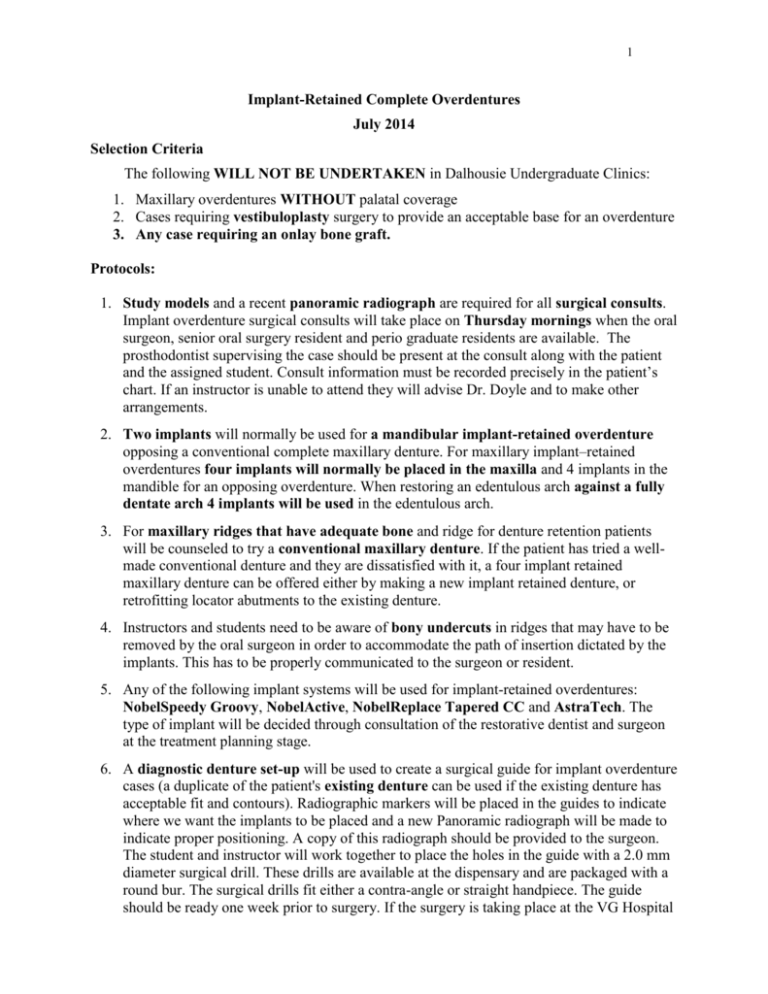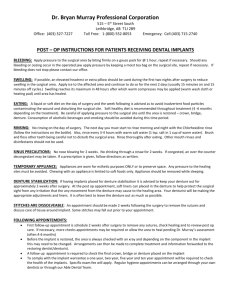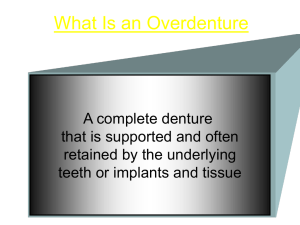Implants_files/Protocol Implant
advertisement

1 Implant-Retained Complete Overdentures July 2014 Selection Criteria The following WILL NOT BE UNDERTAKEN in Dalhousie Undergraduate Clinics: 1. Maxillary overdentures WITHOUT palatal coverage 2. Cases requiring vestibuloplasty surgery to provide an acceptable base for an overdenture 3. Any case requiring an onlay bone graft. Protocols: 1. Study models and a recent panoramic radiograph are required for all surgical consults. Implant overdenture surgical consults will take place on Thursday mornings when the oral surgeon, senior oral surgery resident and perio graduate residents are available. The prosthodontist supervising the case should be present at the consult along with the patient and the assigned student. Consult information must be recorded precisely in the patient’s chart. If an instructor is unable to attend they will advise Dr. Doyle and to make other arrangements. 2. Two implants will normally be used for a mandibular implant-retained overdenture opposing a conventional complete maxillary denture. For maxillary implant–retained overdentures four implants will normally be placed in the maxilla and 4 implants in the mandible for an opposing overdenture. When restoring an edentulous arch against a fully dentate arch 4 implants will be used in the edentulous arch. 3. For maxillary ridges that have adequate bone and ridge for denture retention patients will be counseled to try a conventional maxillary denture. If the patient has tried a wellmade conventional denture and they are dissatisfied with it, a four implant retained maxillary denture can be offered either by making a new implant retained denture, or retrofitting locator abutments to the existing denture. 4. Instructors and students need to be aware of bony undercuts in ridges that may have to be removed by the oral surgeon in order to accommodate the path of insertion dictated by the implants. This has to be properly communicated to the surgeon or resident. 5. Any of the following implant systems will be used for implant-retained overdentures: NobelSpeedy Groovy, NobelActive, NobelReplace Tapered CC and AstraTech. The type of implant will be decided through consultation of the restorative dentist and surgeon at the treatment planning stage. 6. A diagnostic denture set-up will be used to create a surgical guide for implant overdenture cases (a duplicate of the patient's existing denture can be used if the existing denture has acceptable fit and contours). Radiographic markers will be placed in the guides to indicate where we want the implants to be placed and a new Panoramic radiograph will be made to indicate proper positioning. A copy of this radiograph should be provided to the surgeon. The student and instructor will work together to place the holes in the guide with a 2.0 mm diameter surgical drill. These drills are available at the dispensary and are packaged with a round bur. The surgical drills fit either a contra-angle or straight handpiece. The guide should be ready one week prior to surgery. If the surgery is taking place at the VG Hospital 2 the student is responsible to deliver the guide to the designated surgeon at the hospital. It is recommended that the surgical guide is properly identified and left at the main secretarial area at the OMFS Clinic at the VGH. 7. Surgical guides for overdenture cases must be ready for use one week prior to the surgery date for either the Dalhousie or VGH surgery sites. Surgical guides should be approved by the supervising prosthodontist and properly identified for the patient, i.e. patient’s name, date of birth, name of surgeon and planned surgery date. 8. All edentulous cases should be done as two (2) Stage Surgeries unless there are medical issues that determine a One (1) Stage Surgery. 9. Locator abutments will be used to retain overdentures. The Locator measuring tool can be used, but Locator trial kits that should be used to make the final determination of the abutment height. Trial kits should be kept in the dispensary to be signed out by the students. The order for the Locators will then be given to the DA in charge of the implant cupboard (Carol Sauve, at present). 10. Overdenture fabrication will begin no earlier than after six weeks following Stage Two Surgery. 11. The undergraduate student is responsible to adjust or reline existing dentures during the course of implant treatment, i.e. following healing abutment connection. 12. Complete implant overdentures will NOT normally be reinforced with metal frameworks. Exceptions will only be made in high stress situations due to bruxism, dentures lacking sufficient bulk or thickness, any other situation at the discretion of the instructors. Where base metal alloy is to be used, the framework design and wax-up will require approval of the instructor supervising the case. There is a separate fee code and fee for the metal framework reinforcing the denture. We will not make maxillary dentures with the palatal area in metal only. 13. Occlusal principles will be the same for implant supported overdentures and conventional complete dentures as taught at Dalhousie. 14. The specific Locator abutments to be used in patient cases should be connected to the implants being used prior to making Primary Impressions for the fabrication of custom trays. Impression copings will be placed on the locators when making the primary impression. The dental student will follow the sample Lab Rx for custom trays in each Implant Binder in the clinic (and online) and ensure that the student and the lab technicians have access to a copy of this Lab Rx. 15. Custom trays will be fabricated by the production laboratory using the polymethylmethacrylate material we currently use. 16. If retentive caps in overdentures need to be reoriented due to misalignment, the “Quickup” kit will be used intraorally. This kit is available at the dispensary. Directions for use is in the implant binders in the clinic and online. 3 People and Places: As of December 2013: 1. Two extra Locator abutments will be kept on hand for the following heights: #1, 2, 3, 4 and one extra Locator for # 5, 6. 2. Contact information for the Representatives of the Implant companies for Nobel Biocare and AstraTech will be kept in the Implant Binders in the Clinic. 3. Appointments for Implant Surgery or consults are to be booked through Ann Faulkner on Level One. All referrals and Tx Plans that involve the VG Hospital must be faxed to the VG Hospital by Ann Faulkner. 4. Jennifer Wallace is responsible for surgical supplies. Healing abutments are kept in the surgical suites. 5. Carol Sauve is responsible for the implant cupboard D1. Seldom used screwdrivers and other seldom used item i.e. screw drivers from the old Brånemark systems, can be found in this cupboard. To-Do List We have agreed that there could be some issues with the method of lab fabrication of our overdentures at Dalhousie Laboratory. We have had several cases in the last year where the retentive caps are not connecting properly to the locator abutments in the patient’s mouth that required us to remove the retentive housing from the denture and reconnect them intra-orally. Drs. Loney and Doyle will meeting with the lab staff to see if we can sort out this problem. At present, Dr. Richardson is only here on Mondays he and Dr. Doyle will make their own arrangements. July 2014







